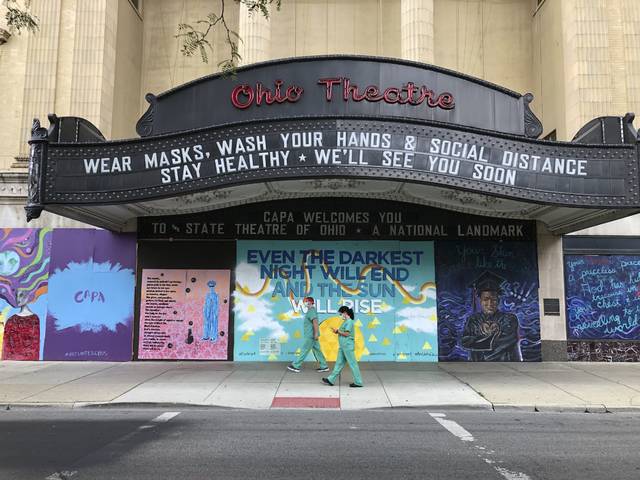
COLUMBUS (AP) — Ohio performing arts groups financially devastated by the coronavirus shutdown received good news this week, tempered by a harsh economic reality.
A public health order from Ohio Gov. Mike DeWine greenlighted performances again, while setting strict audience caps that theater groups say aren’t economically viable — a position with which even the governor himself agrees.
Outdoor entertainment facilities are limited to at most 1,500 people or 15% of a venue’s capacity, whichever figure is smaller, according to a public health order issued Wednesday by DeWine’s interim health director Lance Himes.
Seating in indoor facilities is limited to 300 people or 15% of a venue’s capacity, whichever is less. In reality, those indoor limits could be even smaller depending on how social distancing is maintained in small theaters.
“When you have a business that’s been closed six months, only to reopen at a 15% capacity, it’s obvious to everyone that that’s not a survivable rate,” Angela Meleca, the executive director of Ohio Citizens for the Arts, said in an interview Wednesday. “I don’t know of any business that could be expected to be closed over six months and then reopen without any financial support.”
DeWine’s guidelines came despite recommendations by Ohio theater directors and arts advocacy group Ohio Citizens for the Arts that he should consider less strict limits, or leave decisions up to theater groups altogether.
“We know that the numbers we have set for a commercial production is probably not going to work for them,” DeWine acknowledged, making it clear the priority, for now, is allowing high school productions to go forward.
Unlike restaurants, theaters can’t offer carry-out as an alternative, Meleca said. Unlike college and professional sports, there’s no TV revenue available.
When theaters go dark, it’s more than a loss of ticket revenue, she said. Patrons also aren’t spending money on restaurants, parking, hotel stays and other retail purchases.
“It would be very problematic if the state mandated an across-the-board percentage of occupancy rather than allow venues to creatively reimagine their space utilization to accomplish the same goal,” Meleca wrote in an April 22 letter to the head of the state Development Services Agency.
Allowing theater performances again requires a balancing act between safety and letting shows reopen, said Dan Tierney, the governor’s press secretary. As with sports, theater groups can apply for variances if they think they have an unique space situation, he said.
“The social distancing aspect is first and foremost what we’re focused on, for people to be spaced out safely,” Tierney said.
Ohio’s $41 billion arts and entertainment industry has lost 80,000 jobs and $3.3 billion in revenue, according to a Brookings Institution analysis published this month. That compares with the loss of about 1.4 million jobs and $42.5 billion nationally, the analysis found.
In Cincinnati, the Cincinnati Arts Association — which oversees venues housing the city’s symphony orchestra, opera company, ballet company and more — has laid off nearly half its staff of 95, said president Steve Loftin. The arts-and-entertainment impact of the shutdown in Cincinnati is around $41 million.
In Columbus, theater management organization CAPA has canceled 200 events scheduled for multiple venues it manages around central Ohio, including four historic theaters in and around downtown.
The organization is grateful for DeWine’s acknowledgment in the form of guidelines, but it doesn’t change the fact that 15% capacity prevents most theaters from reopening, said CAPA CEO Chad Whittington.
“We are businesses, and when it comes down to it, we need revenue to cover our expenses just like any other business does,” he said.
In Dayton, The Human Race Theatre Company canceled its March production of “Gloria: A Life,” about feminist advocate — and Toledo native — Gloria Steinem, mid-run, and doesn’t expect to mount shows until next year, said artistic director Kevin Moore. The company, in its 34th year, typically puts on six to seven major productions a year. Its theater, The Loft, holds about 200 seats, meaning 30 seats at most could be filled under the new guidelines.
Many theater companies like Moore’s are making plans to sell tickets for streaming access to performances for patrons who can’t attend in person or have health concerns that keep them away. They say that’s one positive element of DeWine’s guidelines: With shows finally permitted, theater companies can explore alternatives to traditional models.
“It has actually opened up another avenue for us,” said Paul Causman, artistic director of Toledo Repertoire Theatre, which is looking at both in-house and virtual tickets for its plays and musicals.


